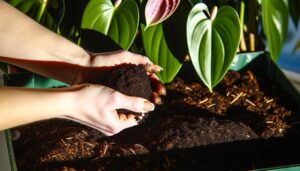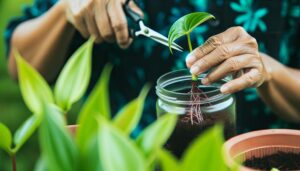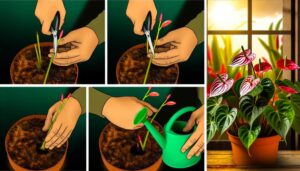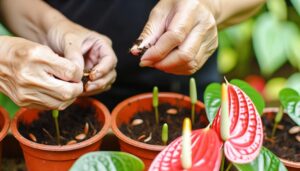How to Care for Anthurium Bakeri: Tips and Tricks
To care for your Anthurium Bakeri, provide bright, indirect light by placing it near a north or east-facing window, and use sheer curtains if needed. Water when the top inch of soil is dry, using filtered water at room temperature.
Choose a well-draining soil mix of orchid bark, perlite, and peat moss and repot every 2-3 years. Feed every 6-8 weeks with diluted, balanced fertilizer during the growing season.
Inspect regularly for pests like aphids and spider mites, and treat with insecticidal soap or neem oil. For more detailed guidance on maintaining a healthy Anthurium Bakeri, continue exploring.

Key Takeaways
- Provide bright, indirect light and avoid direct sunlight to prevent leaf scorch.
- Water when the top inch of soil is dry, using filtered water at room temperature.
- Use a well-draining soil mix consisting of orchid bark, perlite, and peat moss.
- Feed with a balanced, water-soluble fertilizer every 6-8 weeks during the growing season.
- Regularly inspect for pests and treat with insecticidal soap or neem oil if necessary.
Light Requirements

Anthurium Bakeri thrives best in bright, indirect light, which replicates its natural understory habitat.
Position your plant near a north or east-facing window to make sure it gets sufficient light without direct sun exposure. Too much direct sunlight can scorch its leaves, while insufficient light can stunt its growth.
You might consider using sheer curtains to diffuse the light. If natural light is limited, using a grow light with a balanced spectrum can help. Make sure the light source is positioned about 12-18 inches away from the plant.
Regularly rotate the plant to promote even growth and prevent it from leaning towards the light. Monitoring and adjusting the light conditions will help maintain your Anthurium Bakeri’s vibrant foliage and overall health.
Watering Schedule
Maintaining a consistent watering schedule is crucial for the health and growth of your Anthurium Bakeri. Water your plant when the top inch of soil feels dry to the touch.
Overwatering can lead to root rot, so make sure the pot has drainage holes to prevent water from accumulating.
Use room temperature, filtered water to avoid chlorine and fluoride damage. In the growing season (spring and summer), you might need to water more frequently, approximately once a week. During the dormant period (fall and winter), reduce watering to every two weeks.
Always monitor the humidity; Anthurium Bakeri thrives in high humidity, around 60-80%. Mist the leaves or use a humidity tray to maintain ideal moisture levels.
Soil and Repotting
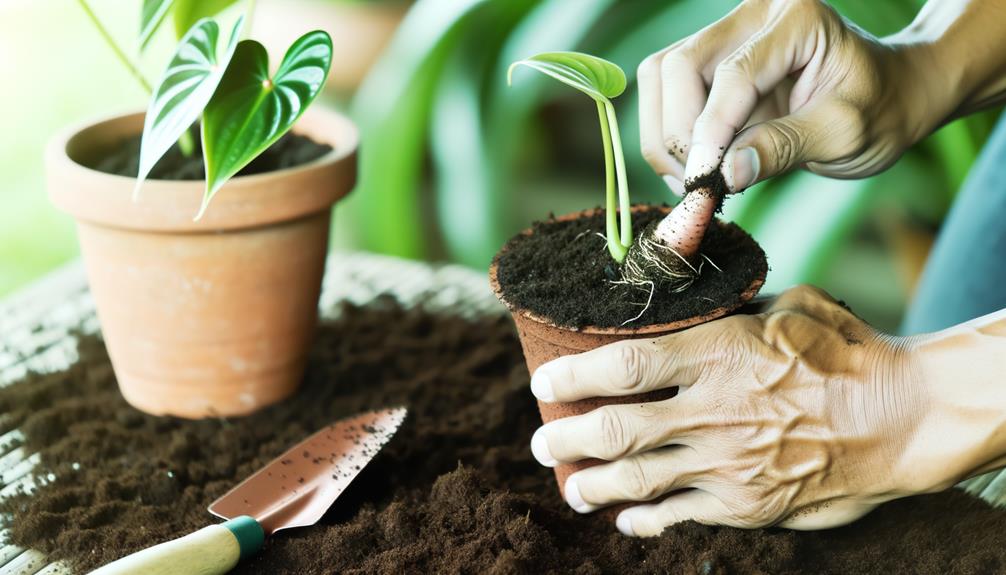
Selecting the right soil mix is crucial for promoting proper drainage and providing the necessary nutrients for your Anthurium Bakeri to flourish.
Opt for a well-draining mix, like one part orchid bark, one part perlite, and one part peat moss. This combination promotes aeration and moisture retention without waterlogging.
When repotting, choose a container one size up to allow for root growth. Gently remove old soil, trim any damaged roots, and place your Anthurium in the new pot, filling around the roots with fresh soil mix. Repot every 2-3 years to refresh the soil and inspect root health.
| Material | Purpose | Ratio |
|---|---|---|
| Orchid Bark | Aeration | 1 part |
| Perlite | Drainage | 1 part |
| Peat Moss | Moisture Retention | 1 part |
| Pot Size | Root Growth | One up |
| Repotting | Soil Refresh | 2-3 yrs |
This promotes optimal development and well-being.
Feeding and Fertilization
How often should you feed your Anthurium Bakeri to guarantee sturdy growth and vibrant blooms?
Feed it every 6-8 weeks during the growing season (spring and summer) with a balanced, water-soluble fertilizer diluted to half strength. This ensures essential nutrients without overwhelming the plant.
Follow these steps for prime fertilization:
- Dilution: Mix the fertilizer at half the recommended strength to avoid nutrient burn.
- Watering: Fertilize after watering to prevent root damage.
- Observation: Monitor for signs of nutrient deficiency, such as yellowing leaves, and adjust feeding accordingly.
Pest and Disease Management

While proper feeding guarantees healthy growth, attentive pest and disease management is equally vital to keep your Anthurium Bakeri thriving.
Regularly inspect your plant for common pests like aphids, spider mites, and mealybugs. If you spot any, immediately isolate the affected plant and treat it with insecticidal soap or neem oil.
Ensure good air circulation to prevent fungal infections such as root rot and leaf blight. Avoid overwatering and allow the soil to dry between waterings to minimize the risk of root rot. Additionally, clean the leaves periodically to prevent dust buildup, which can attract pests.
Conclusion
In caring for your Anthurium bakeri, remember that consistent attention is the key to its flourishing. Provide the right light, water wisely, choose suitable soil, and maintain a regular feeding schedule.
Vigilance against pests and diseases will keep your plant in prime condition. Think of your Anthurium as a delicate balance, like a finely-tuned instrument, requiring careful adjustments to thrive.
With dedication and these tips, your Anthurium will reward you with its lush, vibrant beauty.

